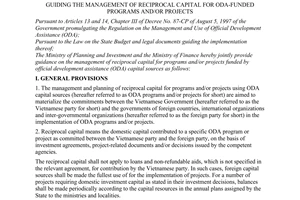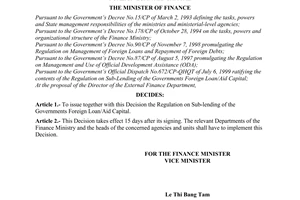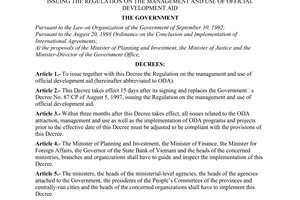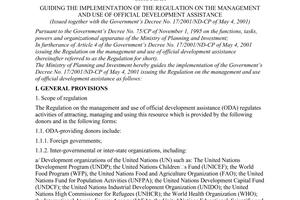Nội dung toàn văn Joint circular No. 02/2003/TTLT-BKH-BTC of March 17, 2003, guiding the elaboration of financial plans for programs and projects using official development assistance (ODA) capital sources
|
THE MINISTRY
OF PLANNING AND INVESTMENT AND |
SOCIALIST
REPUBLIC OF VIET NAM |
|
Hanoi, March 17, 2003 |
JOINT CIRCULAR
GUIDING THE ELABORATION OF FINANCIAL PLANS FOR PROGRAMS AND PROJECTS USING OFFICIAL DEVELOPMENT ASSISTANCE (ODA) CAPITAL SOURCES.
Pursuant to the Governments
Decree No. 17/2001/ND-CP of May 4, 2001, promulgating the Regulation on
management and use of official development assistance (ODA) capital sources;
The Ministry of Planning and Investment and the Ministry of Finance hereby
jointly guide the process of elaborating financial plans for programs and
projects using official development assistance (ODA) capital sources
(hereinafter called ODA programs and projects for short) as follows:
I. GENERAL PROVISIONS
1. Regulation scope:
This Circular contains provisions guiding the elaboration of financial plans for ODA programs and projects during the stages of ODA mobilization: elaboration, appraisal and approval of ODA programs and projects as well as implementation preparation and implementation of ODA programs and projects.
2. Principles for elaboration of financial plans for ODA programs and projects:
The elaboration of financial plans for ODA programs and projects must ensure:
- The observance of current provisions of Vietnamese laws, the commitments between the Vietnamese Government and foreign donors in the implementation of ODA programs and projects.
- The ODA capital mobilization and efficient arrangement of reciprocal capital, avoiding wastefulness and conforming to the actual tempo and capability of deploying ODA programs and projects.
3. Contents of the financial plans of ODA programs, projects:
They include plans on ODA capital (loan capital, non-refundable aid capital, which are split up according to donor countries or organizations); domestic capital (central budget capital, local budget capital, domestic credit capital, investors' own capital, contributed capital of project beneficiaries and other capital sources as prescribed by Vietnamese law).
4. Modes of elaborating financial plans for ODA programs, projects:
4.1. According to domestic financial mechanisms, the ODA programs and projects are classified into the following types:
- ODA programs and projects provided with State budget allocations by the State.
- ODA programs and projects re-loaned by the State.
- ODA programs and projects partly provided with State budget allocations and partly re-loaned by the State.
4.2. The elaboration of the financial plans for the whole or a part of an ODA program or project provided with State budget allocations by the State shall be made in the following forms:
a) The projects on capital construction investment expenditure must have their financial plans elaborated according to capital construction funding sources.
b) The projects on administrative and non-business expenditures must have their financial plans elaborated according to capital sources for administrative and non-business expenditures, concretely according to each domain of expenditure.
c) Where an ODA program or project contains mixed spending contents with components of capital construction expenditures and components of administrative and non-business expenditures (hereinafter called mixed project), the elaboration and implementation of the financial plans shall follow the principle that for the project component containing form of capital construction expenditure, the planning and management of expenditures and the settlement of capital sources shall be the same as those for capital construction investment projects, and for the project component containing form of administrative and nonbusiness expenditures, the planning and managing of expenditures and the settlement of capital sources shall be the same as those for administrative and nonbusiness expenditure projects.
In a number of special cases where either of the two components of a mixed project is too small and the project owner or the project-managing agency requests the elaboration of an unified financial plan according to either of the two project types (capital construction expenditure project or administrative and non-business expenditure project), the Ministry of Planning and Investment shall assume the prime responsibility and coordinate with the Ministry of Finance in considering and deciding it.
4.3. The decisions on ODA program, project investment must clearly state the ODA program or project forms being capital construction expenditure, administrative and non-business expenditure or mixed expenditure under the provisions at Item 4.2 above.
5. Reciprocal capital:
Reciprocal capital shall be arranged according to contents prescribed in Clause 12, Article 5 of the Regulation on Management and Use of Official Development Assistance Sources, promulgated together with the Government's Decree No.17/2001/ ND-CP of May 4, 2001. Concretely as follows:
5.1. All ODA programs and projects which require annual reciprocal capital must be subject to the elaboration of reciprocal capital plans. The managing agencies shall have to sum up requirements and elaborate plans on reciprocal capital of the ODA programs and projects under their direct management.
5.2. Reciprocal capital shall not apply to ODA programs and projects where the signed international agreements do not specify that the Vietnamese side must make contributions, including capital contribution in cash, in kind or other liabilities.
5.3. For ODA programs and projects which are reloaned by the State budget or ODA programs and projects which are partly provided with State budget allocations and partly re-loaned, the project owners must arrange the entire reciprocal capital and give full explanation in the process of project elaboration and approval in term of capability to ensure reciprocal capital.
For projects of the above-mentioned types, the project owners shall be given priority to borrow reciprocal capital from State credit sources and have to repay loan capital (principals and interests) strictly according to credit contracts.
5.4. For projects provided with State budget allocations, the reciprocal capital shall be ensured by the State budget and arranged in the annual State budget estimates according to corresponding capital sources for capital construction or for administrative and non-business expenditures, and specifically decentralized as follows:
- The central budget shall ensure reciprocal capital for ODA programs and projects directly managed and implemented by ministries or central agencies being the project owners.
- The local budgets shall ensure reciprocal capital for projects directly managed by localities being the project owners (including component projects or miniprojects, which are implemented by localities and belong to ODA programs or projects with ministries or central agencies being the project owners).
5.5. Reciprocal capital shall be arranged in annual plans for projects, which satisfy the following conditions: -The international agreements on the projects have come into force.
- The procedures for domestic investment have been completed.
5.6. For ODA programs or projects on which the international agreements have been already signed but not yet come into force, or have already come into force, but the domestic investment procedures have not yet been completed, the project-managing agencies shall have to report such to the Ministry of Planning and Investment and the Ministry of Finance (during the budget estimation) for inclusion in the reserves for capital construction expenditures or each domain of administrative and non-business expenditure (according to the nature of the reciprocal capital) and submission to competent authorities for decision (for cases where the central budget is responsible for arrangement of reciprocal capital), or the project owners shall have to report to the project-managing agencies (during the budget estimation) for inclusion in local budget reserves, submission to the competent authorities for decision (for cases where the local budgets are responsible for arrangement of reciprocal capital).
5.7. The managing agencies must prioritize the arrangement of adequate reciprocal capital in the annual budget estimates in order to fulfill the commitments in the signed international agreements and conform to the actual capability of ODA programs and projects for annual capital disbursement.
The project owners shall have to use the reciprocal capital sources for the right purposes and with efficiency.
II. SPECIFIC PROVISIONS
1. Projection of capital sources and financial mechanisms for programs and projects in the period of ODA mobilization:
1.1. When outlining ODA programs or projects, the managing agencies must clearly point out the financial proposals, including the estimated amounts of ODA capital (loan capital, non-refundable aid capital), reciprocal capital and domestic financial mechanism (the form of detailed outline of programs, projects in Appendix 3, Circular No.06/2001/TT-BKH of September 20, 2001 of the Ministry of Planning and Investment guiding the implementation of the Regulation on Management and Use of Official Development Assistance Source).
1.2. The lists of ODA programs, projects, already approved by the Prime Minister and agreed upon by foreign donors shall serve as basis for making feasibility study reports for ODA programs, projects and the domestic financial mechanism.
1.3. Program, project preparation capital:
Basing themselves on the lists of ODA programs and projects, notified by the Ministry of Planning and Investment, the managing agencies shall elaborate ODA program, project preparation capital plans according to the same process of elaboration and approval of financial plans prescribed in Sections 3 and 4 below, splitting up concretely the capital amounts supplied by donors, self-supplied capital amounts and capital amounts proposed to be supported by the State budget, and send them to the Ministry of Planning and Investment and the Ministry of Finance.
For ODA programs, projects financed separately by donors beyond the plans (or priority ODA mobilization lists) and for which no frame international agreements on ODA are signed, after the Prime Minister approves the undertaking on reception thereof, the managing agencies shall elaborate the program or project preparation capital plans and send them to the Ministry of Planning and Investment and the Ministry of Finance.
2. Projection of investment capital and financial mechanisms for programs and projects during the stage of elaborating, appraising and approving project documents:
Basing themselves on the written notices of the Ministry of Planning and Investment on ODA programs and projects already agreed to consider the financial assistance by donors in each period, the managing agencies shall direct the project owners to make prefeasibility and feasibility study reports or program or project dossiers and submit them to the competent authorities for approval.
2.1. The contents of pre-feasibility study reports of ODA programs, projects:
In the pre-feasibility study reports of ODA programs and projects, which are made under the provisions of the Government's Decree No.52/1999/ND-CP of July 8, 1999 on Investment and Construction Management and Decree No.17/2001/ND-CP of May 4, 2001 promulgating the Regulation on ODA Management and Use, the following contents should be clearly expressed:
- The projected structures and forms of specific donation or co-donation of donors for components of ODA programs, projects.
- The capability to ensure reciprocal capital from the sources of: self-balance by project owners, credit capital, contributed capital of beneficiaries and other capital sources.
Where the mechanism of re-lending is applied, the project owners must base on frame re-lending conditions prescribed in the Government's Regulation on re-lending of foreign loan capital, issued together with the Finance Minister's Decision No.02/2000/QD-BTC of January 6, 2000 to elaborate preliminary plans on capital payback of the projects.
2.2. Feasibility study reports of ODA programs or projects:
In the feasibility study reports of ODA programs or projects, made according to the provisions in the Government's Decree No.52/1999/ND-CP of July 8, 1999 on Investment and Construction Management and Decree No.17/2001/ND-CP of May 4, 2001 promulgating the Regulation on ODA Management and Use, the following contents must be clearly expressed:
- The specific conditions on domestic and foreign capital sources supplied for programs, projects (such as the lending term, the grace period, the interest rates, the borrowing fees and other conditions...).
- The domestic financial mechanism applicable to programs, projects (allocated or re-loaned).
Where the re-lending mechanism is applied, the project owners must work out detailed plans on capital payback (according to debt repayment periods, revenue sources...), based on the frame re-lending conditions prescribed in the Government's Regulation on re-lending of foreign loan capital, issued together with the Finance Minister's Decision No.02/2000/QD-BTC of January 6, 2000. Where these frame conditions cannot be applied to projects, the specific reasons therefor must be justified and re-lending conditions suitable to each type of project and financial assistance sources must be proposed so that the Ministry of Finance shall assume the prime responsibility for considering together with the concerned agencies and submitting them to the Prime Minister for decision.
2.3. The decisions approving the feasibility study reports must be inscribed fully with the specific contents mentioned in Section 2.2 above, clearly prescribing the domestic financial mechanism for programs, projects, including forms and modes of capital transfer between the parties involved in the programs, projects, detailing each component of capital construction expenditures, administrative and non-business expenditures and clearly decentralizing spending tasks between the budget levels in the arrangement of reciprocal capital.
2.4. Basing themselves on feasibility study reports, project documents, which are already approved by competent authorities, the project owners shall elaborate and send to the managing agencies, the Ministry of Planning and Investment and the Ministry of Finance the plans on capital use according to the tempo of project implementation, divided according years from the first year to the year of completing and putting the projects to use, splitting up concretely ODA capital (according to each donor), reciprocal capital: according to form of State budget allocation (capital construction, administrative and non-business expenditures), re-lending and other forms (according to forms in Appendix 1 to this Circular).
3. The process of elaborating, approving and assigning annual financial plans for ODA programs and projects:
3.1. The process of elaborating, approving and assigning plans on capital for program or project preparation, capital for implementation preparation and implementation of ODA programs, projects shall comply with the process of State budget elaboration and approval, as prescribed in the State Budget Law and legal documents on management of investment and construction.
3.2. Bases for elaboration of financial plans for ODA programs, projects:
-The international agreements already signed with foreign donors;
- The regulations on elaboration of State budget plans and estimates; the current financial spending regimes and norms;
- The actual tempo and capability of project implementation.
Annually, by the time of State budget estimation, basing themselves on the above-mentioned regulations and situation, the project owners shall elaborate the financial plans for ODA programs, projects and send them to the superior managing agencies for synthesis. If they are projects using re-loaned capital, these plans must also be sent to the re-lending agencies.
The financial plans must be elaborated strictly according to forms in Appendix 2 to this Circular, enclosed with reports clearly explaining the bases and grounds for calculation, analysis and assessment of the implementation situation, specific obstacles and problems and proposing remedial measures; and must be sent strictly according to regulations on time prescribed by the managing agencies in order to ensure time for synthesis of annual State budget estimates.
3.3. The managing agencies shall sum up the annual implementation situation and project next year's financial plans for ODA capital and reciprocal capital of ODA programs, projects within their management domains and send them to the Ministry of Planning and Investment and the Ministry of Finance (according to forms prescribed in Appendix 3 to this Circular).
3.4. Basing themselves on the financial plans for ODA programs, projects, forwarded by the managing agencies, the Ministry of Planning and Investment and the Ministry of Finance shall assume the prime responsibility in considering and synthesizing the annual financial plans of ODA programs, projects, and on that basis incorporate them into the annual State budget estimates according to the following assignment:
- The Ministry of Planning and Investment shall assume the prime responsibility for capital construction investment projects or capital construction components of mixed projects.
- The Ministry of Finance shall assume the prime responsibility for administrative and non-business projects or administrative and non-business components of mixed projects.
After the State budget estimates are decided by competent authorities, the Ministry of Planning and Investment and the Ministry of Finance shall assign the State budget estimates to the managing agencies strictly according to current regulations, clearly inscribing the foreign capital of ODA programs, projects.
Basing themselves on State budget estimates assigned or decided by competent bodies, the managing agencies shall assign detailed plans on allocation of capital (including ODA capital and reciprocal capital) to ODA programs, projects, and at the same time notify the finance agencies and State treasury offices of the same level thereof.
3.5. Basing themselves on the notices of competent agencies, the State Treasuries shall control and pay reciprocal capital according to the current regime on State budget allocation (the capital construction capital shall be controlled and paid according to the capital construction investment regime, the administrative and non-business capital shall be controlled and paid according to the administrative and non-business funding regime).
4. Adjusting financial plans, transferring reciprocal capital and handling unexpected cases outside the plans:
4.1. The managing agencies shall base on the situation of implementation of ODA programs, projects to adjust or propose the competent bodies to adjust the annual financial plans for programs, projects according to current regulations, and on that basis to transfer the portions of State budget-allocated reciprocal capital from programs, projects, where they cannot be used up to other ODA programs, projects with complete procedures and full capacity to surpass the annual plans, and at the same time notify the finance bodies and the State treasuries of the same level thereof. The State Treasuries shall carry out procedures for payment. In case of meeting unexpected difficulties in reciprocal capital, the project owners must report such to the managing agencies for remedies.
The transfer of reciprocal capital from projects with capital surplus to projects with capital shortage shall be effected only within the same expenditure domain. The reciprocal capital of projects in the domain of capital construction investment expenditures must not be transferred to projects in the domain of regular expenditures and vice versa; the capital must not be transferred from the health domain to the education and training domain and vice versa.
4.2. For ODA programs, projects with reciprocal capital being unable to be arranged in time in the annual budget plans or with unexpected demands for reciprocal capital (projects with reciprocal capital ensured by the State budget), the managing agencies must themselves arrange them within the assigned budget scope. Where they cannot arrange them by themselves, they are allowed to use the capital reserve sources mentioned at Point 5.6, Part I of this Circular.
5. Using and repaying advance capital (according to the provisions in Article 27 of the Government's Decree No.17/20011ND-CP of May 4, 2001):
5.1. Advance capital means State budget capital advanced according to annual plans to ODA programs and projects, which are entitled to State budget allocations, for the execution of a number of items of the programs, projects committed to be provided with financial assistance from ODA capital sources and already included in the plans, but the ODA capital therefor have not yet been withdrawn, hence the project owners have no capital sources for deployment of work. The budget levels which are responsible for reciprocal capital allocation (stated at Point 5.4, Part 1) shall also be responsible for arrangement of this advance capital.
5.2. The advance capital shall be applied only to projects or project components, which are entitled to "capital payback" mode of capital withdrawal specified in international agreements on ODA.
Starting from the plan year when arises this mode of capital withdrawal and based on the spending levels and necessary duration for withdrawal of capital from donors, the projects must determine and inscribe in the plan the reciprocal capital of that year so as to be provided with a capital amount advanced from the State budget.
5.3. The finance agencies of all levels shall coordinate with the offices of planning and investment of the same levels in considering and deciding on the arrangement of capital for programs, projects with demands for advance capital.
The repayment of advance capital must be settled annually and the State Treasuries at all levels shall have to retrieve such capital for the State budget (depending on which budget level that has arranged advance capital for projects) at the end of the plan year. The finance agencies of all levels shall have to continue to arrange the advance capital according to next year's plan (if so demanded) in order to ensure the continuity in the project implementation.
6. Report on implementation of financial plans:
The project owners and the managing agencies shall have to periodically report on the situation of implementation of financial plans according to the provisions in Circular No.06/2001/TT-BKH of September 30, 2001 of the Ministry of Planning and Investment guiding the implementation of the Regulation on ODA Management and Use, issued together with the Government's Decree No.17/2001/ ND-CP of May 4, 2001. The periodical reports on situation of implementation of financial plans of ODA programs, projects shall serve as basis for ODA mobilization and financial plan elaboration for programs, projects.
III. IMPLEMENTATION PROVISIONS
This Circular takes implementation effect 15 days after its promulgation and replaces Joint Circular No.6/1998/TTLT-BKH-BTC of August 14,1998 of the Ministry of Planning and Investment and the Ministry of Finance guiding the mechanism for management of reciprocal capital for ODA programs, projects. The previous provisions contrary to this Circular hereby cease to be effective. Any problems arising in the course of implementation should be reported to the Ministry of Planning and Investment and the Ministry of Finance for study of amendments and supplements.
|
MINISTER OF PLANNING AND
INVESTMENT |
MINISTER OF FINANCE |





